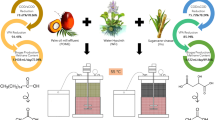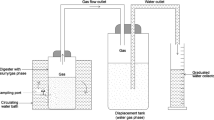Abstract
The purpose of this work was to study the anaerobic co-digestion of all the by-products generated during the processing of used vegetable oils (UVO) with the objective of proposing a solution for the treatment of these wastes. More specifically, this study investigates the advantages of two-phase anaerobic digestion for treating a mixture (1/5 v/v) of UVO processing wastes (OW) and pig manure (PM) using two semi-continuous digesters operated at mesophilic temperature (37 ± 1 °C). The experiments were conducted at hydraulic retention time (HRT) of 0.5, 1, 2 and 4 days in the first stage (acidifier) and at HRT of 11.5, 15, 18 and 20 days in the second stage (methaniser). The results revealed that the HRT had a high influence on the soluble chemical oxygen demand (sCOD) and total dissolved solids (TDS) removal. The maximum total sCOD removal efficiency of 86.4 % and TDS removal efficiency of 81.9 % was achieved at 20 days of global HRT. The maximum biogas production of 0.65 m3 per kilogramme of volatile dissolved solids (VDS) was removed, corresponding to a methane production of 0.42 m3 CH4 kg−1. VDS removed (65 % CH4) was also achieved at 20 days of HRT. The two-phase digestion system showed good stability, which was mainly attributed to the strong buffering capacity with the two-phase system and the high alkalinity from PM when co-digested with OW. The results obtained from this study provide fundamental information for scaling up a high-performance two-phase anaerobic system in the future.






Similar content being viewed by others
References
Ahrin BK (2003) Perspectives for anaerobic digestion. In: Ahring BK (ed) Biomethanation I. Advances in biochemical engineering/biotechnology. Sringer, Berlin, pp 1–30
American Public Health Association (APHA) (2005) Standard methods for the examination of water and wastewater, 21th edn. APHA, Washington, DC
Angelidaki I, Ahing BK (1997) Co-digestion of olive mill wastewaters with manure, household waste or sewage sludge. Biodegradation 8:221–226
Angelidaki I, Ahing BK, Deng H, Schmidt JE (2002) Anaerobic digestion of olive mill effluents together with swine manure in USAB reactors. Water Sci Technol 45(10):213–218
Appels L, Lauwers J, Degrève J, Helsen L, Lievens B, Willems K, Van Impe J, Dewil R (2011) Anaerobic digestion in global bio-energy production: potential and research challenges. Renew Sust Energy Rev 15(9):4295–4301
Beccari M, Majone M, Torrisi L (1998) Two-reactor system with partial phase separation for anaerobic treatment of olive oil mill effluents. Water Sci Technol 38(4–5):53–60
Borja R, Banks CJ (1995) Anaerobic digestion of ice-cream wastewater: a comparison of single and two phase reactor systems. Bull Environ Contam Toxicol 54(3):466–471
Borja R, Rincón B, Raposo F, Alba J, Martin A (2002) A study of anaerobic digestibility of two-phase olive mill solid waste (OMSW) at mesophilic temperature. Process Biochem 38:733–742
Bouallagui H, Touhami Y, Cheikh RB, Hamdi M (2005) Bioreactor performance in anaerobic digestion of fruit and vegetable. Process Biochem 40:989–995
Chhetri AB, Tango MS, Budge SM, Islam MR (2008) Non-edible plant oils as new sources for biodiesel production. Int J Mol Sci 9:169–180
Cirne D, Paloumet X, Björnsson L, Alves M, Mattiassona B (2007) Anaerobic digestion of lipid-rich waste—effects of lipid concentration. Renew Energy 32:965–975
de Lemos (2007) Anaerobic reactors: biological wastewater treatment, vol 4. IWA Publishing, London
Demirel B, Yenigün O (2002) Two-phase anaerobic digestion processes: a review. J Chem Technol Biotechnol 77(7):743–755
Demirer GN, Chen S (2005) Two-phase anaerobic digestion of unscreened dairy manure. Process Biochem 40:3542–3549
EU (2006) Biofuels in the European Union-A vision for 2030 and beyond. Report of the biofuel research advisory council
Fezzani B, Cheikh RB (2007) Anaerobic co-digestion of olive mill wastewater with olive mill solid waste in a tubular digester at a mesophilic temperature. Bioresour Technol 98:769–774
Göblös S, Portörő P, Bordás D, Kálmán M, Kiss I (2008) Comparison of the effectivities of two-phase and single-phase anaerobic sequencing batch reactors during dairy wastewater treatment. Renew Energy 33(5):960–965
Grady C, Daigger G, Lim H (1999) Biological wastewater treatment, 2nd edn. Marcel Dekker, New York
Guerrero L, Omil F, Mendez R, Lema JM (1999) Anaerobic hydrolysis and acidogenesis of wastewaters from food industries with high content of organic solids and protein. Water Res 33(15):3281–3290
Hidalgo D, Sastre E, Gómez M, Nieto P (2013) Evaluation of pre-treatment processes for increasing biodegradability of agro-food wastes. Environ Technol 33(13):1497–1503
Hong V (2011) Anaerobic digestion of oil-rich solid waste. J Biotechnol 9(1):45–53
Ince O (1998) Performance of a two-phase anaerobic digestion system when treating dairy wastewater. Water Res 32(9):2707–2713
Kulkarni MG, Dalai AK (2006) Waste cooking oil—an economical source for biodiesel: a review. Ind Eng Chem Res 45:2901–2913
Lalman JA, Bagley DM (2001) Anaerobic degradation and methanogenic inhibitory effects of oleic stearic acids. Water Res 35(12):2975–2983
Lesteur M, Bellon-Maurel V, Gonzalez C, Latrille E, Roger JM, Junqua G, Steyer JP (2010) Alternative methods for determining anaerobic biodegradability: a review. Process Biochem 45:431–440
Li R, Chen S, Li X (2010) Biogas production from anaerobic co-digestion of food waste with dairy manure in a two-phase digestion system. Appl Biochem Biotechnol 160(2):643–654
Mobarak-Qamsari E, Kasra-Kermanshahi R, Nosrati M, Amani T (2012) Enzymatic pre-hydrolysis of high fat content dairy wastewater as a pretreatment for anaerobic digestion. Int J Environ Res 6(2):475–480
Neves L, Pereira M, Mota M, Alves M (2009) Detection and quantification of long chain fatty acids in liquid and solid samples and its relevance to understand anaerobic digestion of lipids. Bioresour Technol 100(1):91–96
Palenzuela A (1999) Anaerobic digestion of fish processing wastewater with special emphasis on hydrolysis of suspended solids. A.A. Balkema, The Netherlands
Pastor L, Ruiz L, Pascual A, Ruiz B (2013) Co-digestion of used oils and urban landfill leachates with sewage sludge and the effect on the biogas production. Appl Energy 107:438–445
Pereira MA, Pires OC, Mota M, Alves MM (2005) Anaerobic biodegradation of oleic and palmitic acids: evidence of mass transfer limitations caused by long chain fatty acid accumulation onto the anaerobic sludge. Biotech Bioeng 92(1):15–23
Refaat A (2010) Different techniques for the production of biodiesel from waste vegetable oil. Int J Environ Sci Tech 7(1):183–213
Salminen E, Rintala J, Lokshina LYA, Vavilin VA (2000) Anaerobic batch degradation of solid poultry slaughterhouse waste. Water Sci Technol 41:33–41
SenthilKumar M, Gnanapragasam G, Arutchelvan V, Nagarajan S (2011) Influence of hydraulic retention time in a two-phase upflow anaerobic sludge blanket reactor treating textile dyeing effluent using sago effluent as the co-substrate. Environ Sci Pollut Res 18:649–654
Shen F, Yuan H, Pang Y, Chen S, Zhu B, Zou D, Liu Y, Mac J, Yu L, Li X (2013) Performances of anaerobic co-digestion of fruit & vegetable waste (FVW) and food waste (FW): single-phase vs. two-phase. Bioresour Technol 144:80–85
Solera R, Romero LI, Sales D (2002) The evolution of biomass in a two-phase anaerobic treatment process during start-up. Chem Biochem Eng Q 16(1):25–29
Torrijos M, Thalla AK, Sousbie P, Bosque F, Delgene’s JP (2008) Anaerobic digestion of residues from production and refining of vegetable oils as an alternative to conventional solutions. Water Sci Technol 58(9):1871–1878
Travieso L, Dominguez JR, Rincón B, Sánchez E, Benítez F, Borja R, Raposo F, Colmenarejo MF (2008) Batch culture growth of chlorella zofingiensis on effluent derived from two-stage anaerobic digestion of two-phase olive mill solid waste. Electron J Biotechnol 11(2):1–8
Wang Z, Banks CJ (2003) Evaluation of a two-stage anaerobic digester for the treatment of mixed abattoir wastes. Process Biochem 38(9):1267–1273
Wust E (2003) Single-phase and two-phase cheese wastewater treatment by anaerobic SBRs. PhD thesis, Civil, Construction and Environmental Engineering Department, Marquette University, Milwaukee, Wisconsin
Yang YQ, Shen DS, Li N, Xu D, Long YY, Lu XY (2013) Co-digestion of kitchen waste and fruit-vegetable waste by two-phase anaerobic digestion. Environ Sci Pollut Res Int 20(4):2162–2167
Yu HW, Samani Z, Hanson A, Smith G (2002) Energy recovery from grass using two-phase anaerobic digestion. Waste Manag 22:1–5
Zhang B, Cai W, He P (2007) Influence of lactic acid on the two-phase anaerobic digestion of kitchen wastes. J Environ Sci 19:244–249
Zhang P, Chen Y, Zhou Q (2010) Effect of surfactant on hydrolysis products accumulation and short-chain fatty acids (SCFA) production during mesophilic and thermophilic fermentation of waste activated sludge: kinetic studies. Bioresour Technol 101(18):6902–6909
Zhang L, Lee YW, Jahng D (2011) Anaerobic co-digestion of food waste and piggery wastewater: focusing on the role of trace elements. Bioresour Technol 102(8):5048–5059
Zhou X, Meile L, Kreuzer M, Zeitz J (2013) The effect of saturated fatty acids on methanogenesis and cell viability of Methanobrevibacter ruminantium. Archaea. doi:10.1155/2013/106916
Acknowledgments
The authors gratefully acknowledge support of this work by the LIFE + Program under the responsibility of the Directorate General for the Environment of the European Commission through the agreement LIFE 09 ENV/E/000451-VALUVOIL project.
Author information
Authors and Affiliations
Corresponding author
Rights and permissions
About this article
Cite this article
Hidalgo, D., Gómez, M., Martín-Marroquín, J.M. et al. Two-phase anaerobic co-digestion of used vegetable oils’ wastes and pig manure. Int. J. Environ. Sci. Technol. 12, 1727–1736 (2015). https://doi.org/10.1007/s13762-014-0560-9
Received:
Revised:
Accepted:
Published:
Issue Date:
DOI: https://doi.org/10.1007/s13762-014-0560-9




